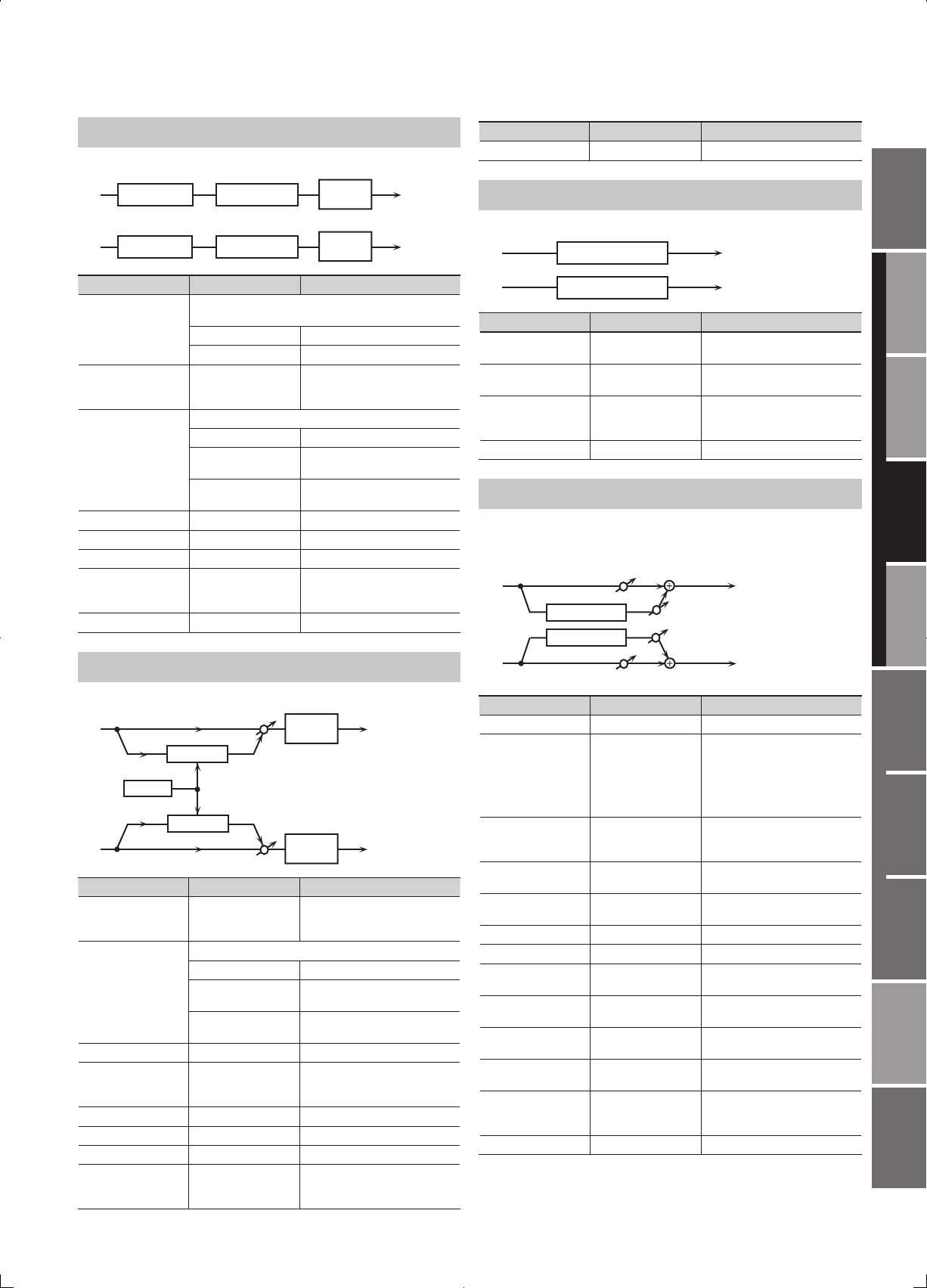
69
Overview
Appendix
USB Memory
Song Player
Digital Recorder
Synthesizer
Selecting Sounds Perform. Functions Editing/Eects Other Settings
Rec/Play/Edit Eects Rhythm Pattern
57: LOFI COMPRESS
This is an eect that intentionally degrades the sound quality for creative purposes.
L in
R in
L out
R out
Compressor
Lo-Fi
Lo-Fi
Compressor
2-Band
EQ
2-Band
EQ
Parameter Value Explanation
Pre Filter Type
Selects the type of lter applied to the sound before it
passes through the Lo-Fi eect.
1 Compressor o
2–6 Compressor on
LoFi Type 1–9
Degrades the sound quality. The
sound quality grows poorer as
this value is increased.
Post Filter Type
Type of lter
OFF No lter is used
LPF
Cuts the frequency range above
the Cuto
HPF
Cuts the frequency range below
the Cuto
Post Filter Cuto 200–8000 Hz Basic frequency of the Post Filter
Low Gain -15–+15 dB Gain of the low range
High Gain -15–+15 dB Gain of the high range
Balance # D100:0W–D0:100W
Volume balance between the
direct sound (D) and the eect
sound (W)
Level # 0–127 Output Level
58: LOFI RADIO
In addition to a Lo-Fi eect, this eect also generates radio noise.
R in
R out
L in
L out
Lo-Fi
Lo-Fi
Radio
2-Band
EQ
2-Band
EQ
Parameter Value Explanation
LoFi Type 1–9
Degrades the sound quality. The
sound quality grows poorer as
this value is increased.
Post Filter Type
Type of lter
OFF No lter is used
LPF
Cuts the frequency range above
the Cuto.
HPF
Cuts the frequency range below
the Cuto.
Post Filter Cuto 200–8000 Hz Basic frequency of the Post Filter
Radio Detune # 0–127
Simulates the tuning noise of a
radio. As this value is raised, the
tuning drifts further.
Radio Noise Level # 0–127 Volume of the radio noise
Low Gain -15–+15 dB Gain of the low range
High Gain -15–+15 dB Gain of the high range
Balance # D100:0W–D0:100W
Volume balance between the
direct sound (D) and the eect
sound (W)
Parameter Value Explanation
Level 0–127 Output Level
59: TELEPHONE
This eect produces a mued sound, like that heard through a telephone.
L in
R in
L out
R out
Telephone
Telephone
Parameter Value Explanation
Voice Quality # 0–15
Audio quality of the telephone
voice
Treble -15–+15 dB
Bandwidth of the telephone
voice
Balance # D100:0W–D0:100W
Volume balance between the
direct sound (D) and the eect
sound (W)
Level 0–127 Output Level
60: PHONOGRAPH
Simulates a sound recorded on an analog record and played back on a record player.
This eect also simulates the various types of noise that are typical of a record, and
even the rotational irregularities of an old turntable.
L in
R in
Phonograph
Phonograph
L out
R out
Balance W
Balance W
Balance D
Balance D
Parameter Value Explanation
Signal Distortion 0–127 Depth of distortion
Frequency Range 0–127
Frequency response of the
playback system
Decreasing this value will
produce the impression of an old
system with a poor frequency
response.
Disc Type LP, EP, SP
Rotational speed of the turntable
This will aect the frequency of
the scratch noise.
Scratch Noise Level 0–127
Amount of noise due to scratches
on the record
Dust Noise Level 0–127
Volume of noise due to dust on
the record
Hiss Noise Level 0–127 Volume of continuous “hiss”
Total Noise Level # 0–127 Volume of overall noise
Wow 0–127
Depth of long-cycle rotational
irregularity
Flutter 0–127
Depth of short-cycle rotational
irregularity
Random 0–127
Depth of indenite-cycle
rotational irregularity
Total Wow/Flutter # 0–127
Depth of overall rotational
irregularity
Balance # D100:0W–D0:100W
Volume balance between the
direct sound (D) and the eect
sound (W)
Level 0–127 Output Level


















